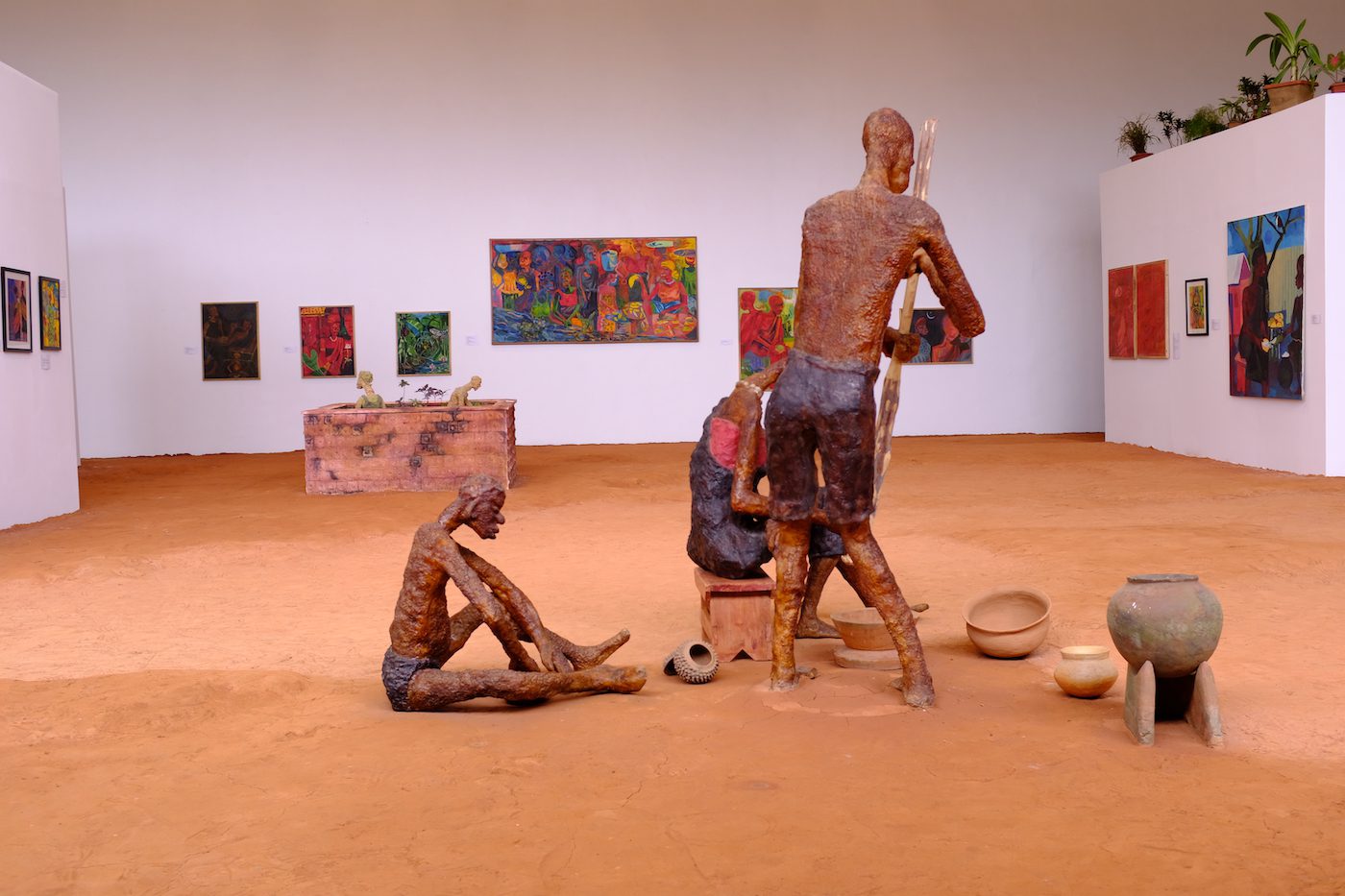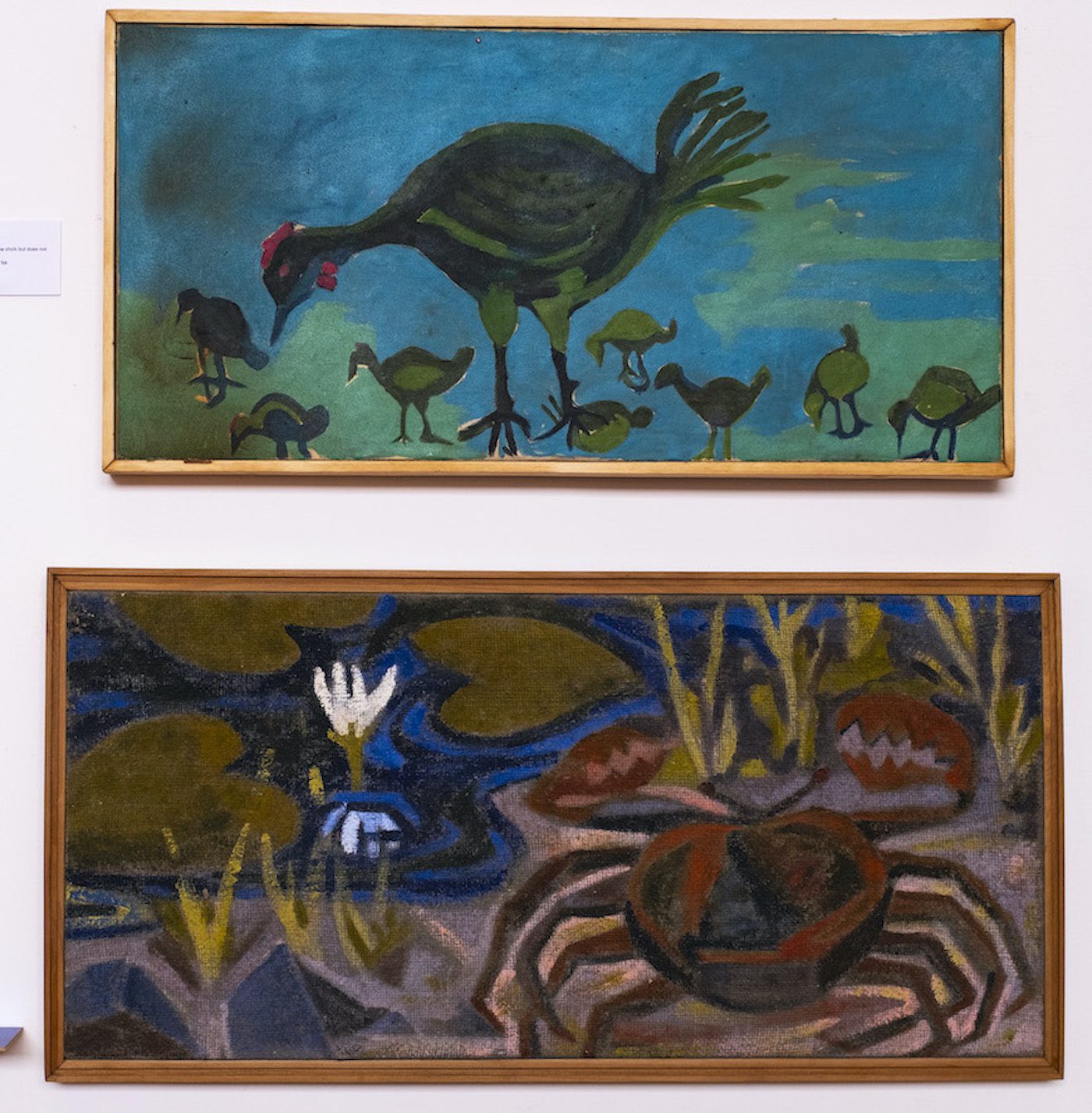The retrospective at the Savannah Centre for Contemporary Art in Tamale, Ghana reflects on Agyeman Ossei’s methods of translating tradition into contemporary imagery.

An assemblage depicting a couple pounding fufu while a child sits to the side. Photo: Kelvin Haizel
There is a 1977 highlife song by Obuoba J. A. Adofo and the City Boys International Band titled “Akutia Bo,” which means: “to cast insinuations.” Part of the lyrics could be translated as such: “the one at the receiving end of an insinuation knows that the insinuation is theirs / trouble announces its presence.” In the Akan language, which is used in some southern regions of present-day Ghana and Ivory Coast, the idea of the unmentionable is important. An object of abuse is targeted with subtle and indirect verbal attack, for example, often using labels. Traditionally, the term “akutia” means to disturb peace, to stir up – something that the English equivalent, “insinuations,” cannot quite carry.
The word was chosen as the title for a retrospective of Agyeman Ossei’s life work, presently showing in Ghana, at the Savannah Centre for Contemporary Art and the Red Clay studios. It is a show that focuses largely on Akan adages. The title seeks to redefine the meaning of akutia as a peaceful proposal of self-expression facilitated through humor, irony, and sarcasm. The subtitle Blindfolding the Sun and the Poetics of Peace, is derived from two Akan proverbs. While the first part alludes to God (“one person’s hands cannot blindfold God”), “poetics of peace” suggest that there will always be peace when the speaker and the listener of proverbs live together.
Fiercely independent in thought, Agyeman Ossei has continuously worked with irreverence for the art market. But there is a paradox: even though he might dismiss certain generally accepted rules of the market, he seems to find success through turning to traditional art or aesthetics and incorporating them into European forms.
Various Ghanaian artists tried to respond to the emergent postcolonial “African Personality” movement as championed in the 1960s by Ghana’s first president, Kwame Nkrumah. Kofi Antubam, perhaps the most prominent artist of that era, devised female beauty aesthetics as oval and circle shapes based on the Akan Akuaba fertility doll. Vincent Kofi and Oku Ampofo’s sculptures leant towards a “neo-primitivism” which prioritized “poetic and spiritual themes” over form. And in painting, Kobina Bucknor’s sculptural forms stylized two-dimensional realism in bright colors.
Using Akan proverbs as a motif, Agyeman Ossei (b. 1960) blurs the lines between illustration and translation.
As you come through the entrance of the Savannah Centre for Contemporary Art, you will notice that the layout of the exhibition breaks the white cube idea: The sides are two unequal elongated L-shaped walls with an adjacent wall from the main building structure. A row of plants sits on top of the right-hand side wall. The walls are disjointed and allow meandering. In between them are two fountains – one contains sculptures and plants, and the other plants only. The floor is paved with clay plastered on anthill blocks, paving blocks, and cladding bricks of different sizes.

Agyeman Ossei (b.1960), Twi: Akokɔbaatan nan tia ba, enkum ba; English: The mother hen may step on the chick but does not kill the chick; Dagbani: Noo nɔri o bihi amaa di bi kuri ba , 1992 . Oil on canvas, 95.5cm * 45.5cm. Photo: Kelvin Haizel
This layout was inspired by the artist’s place of abode, according to the cocurators of the exhibition, Adwoa Amoah, Kwasi Ohene-Ayeh, and Tracy Naa Koshie Thompson. It might equally have been inspired by the so-called garden sculptures of the Nkrumah era, when public commissions saw artists installing their works in the landscapes of universities, hotels, and other institutions.
The scenery is intimately domestic, like that of an Akan compound house. An assemblage depicts a couple pounding fufu while a child sits to the side. Nearby, a pot sits on a traditional cooking stove. The sculptures have grotesque faces and snarling mouths. Elsewhere, at the Red Clay Studios, similar sculptural forms populate an animation film based on a novel Ossei is writing, while the domestic scenery appears in paintings. In addition, two male figures play the boardgame Oware.

Agyeman Ossei (b.1960), Twi: Baako ɛyɛ ya; English: To be alone is painful; Dagbani: Ayi bɛ a ko di mali biɛrim, 2020 . Oil on canvas, 152.5cm * 183.5cm. Photo: Kelvin Haizel
The paintings could roughly be classified into two types: those which translate adages and those that illustrate adages. For example, in the painting Baako ɛyɛ ya (2020) (“To be alone is painful”), a man draped in clothing sits alone in a local bar. His hands are stretched forward, holding a calabash, as he is served by an attendant. Similarly, in the painting Akokɔbaatan nan tia ba, enkum ba (1992) (‘’The foot of a hen steps on the chick but it does not kill the chick’’), a hen leads several chicks to feed. These pieces could be considered as illustrative pieces.

Agyeman Ossei (b.1960), Twi: Obi ntɔn n’akokɔ bedeɛ kwa (#for Edem); English: No one sells their laying hen for nothing; Dagbani: So m-bi mi biɛɣuni, 1996. Oil on canvas, 90cm * 76cm. Photo: Kelvin Haizel
In contrast, the painting Obi ntɔn n’akokɔ bedeɛ kwa (1996) (“No one sells their laying hen for nothing”) shows a woman approaches a pipe-smoking man with a calabash. The man seems unimpressed, and is not looking towards the woman. To the side of the couple, a child sits, her right hand dipped in a bowl. It seems unclear who is alluded to as the “laying hen” and why. This could be interpreted as the artist translating the proverbs in his own way.
Even though the exhibition is based on Akan adages, it shows in a geographical area that is widely inhabited by Dagomba. Attempting to bridge the gap are captions translated into the major local language, but I find myself wondering what has been lost in translation.
Kwabena A. Yeboah is a journalist who reports on the arts, culture, health and science, and politics in Ghana.
More Editorial